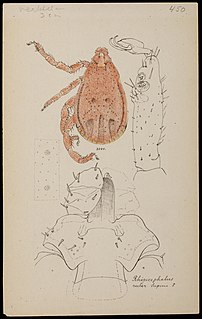Kyasanur forest disease (KFD) is a tick-borne viral haemorrhagic fever endemic to South-western part of India. The disease is caused by a virus belonging to the family Flaviviridae. KFDV is transmitted to humans through the bite of infected hard ticks which act as a reservoir of KFDV.

Haemaphysalis is a genus of ticks, containing these species:
The Bhanja virus is a tick-borne virus first discovered in a tick taken from a paralyzed goat in Bhanjanagar, India in 1954. Bhanja virus in humans was first documented in 1974 when Charles Calisher was working with the virus in a lab and contracted it himself. His experience with the virus was mild and included symptoms of mild aching in muscles and joints, moderate headache, slight photophobia. The Bhanja virus is a member of the Bhanja virus serocomplex and is a member of the Bunyavirales order.
Pylore Krishnaier Rajagopalan is an Indian vector control scientist, biologist and acarologist, known for his pioneering contributions to the control programmes against vector-borne diseases in India.[1] He is a former director of the Indian Council of Medical Research managed Vector Control Research Centre, Pondicherry.[2][3] He graduated in 1949 from the Banaras Hindu University and obtained a Masters in Zoology with University First Rank there itself in 1951. In 1952 he joined the fledgling Virus Research Centre in Pune, and worked under the supervision of some of the finest vector control specialists such as Dr T Ramachandra Rao. In recognition of his outstanding work as a young research scientist, in 1957 he was awarded a Fellowship by the Rockefeller Foundation to pursue a Master's program in Public Health from the University of California.[4] He went on to secure a Diploma in Acarology from the University of Maryland at College Park.
Ixodes petauristae is a hard-bodied tick of the genus Ixodes. It is found in India and Sri Lanka. Adults parasitize various smaller mammals such as Ratufa indica, Funambulus tristriatus, Macaca radiata, Petaurista sp. and mice. It is a potential vector of Kyasanur Forest disease virus,
Ixodes ceylonensis is a hard-bodied tick of the genus Ixodes. It is found in India and Sri Lanka. It is an obligate ectoparasite of mammals.
Haemaphysalis aculeata is a hard-bodied tick of the genus Haemaphysalis. It is found in India and Sri Lanka.
Haemaphysalis bispinosa is a hard-bodied tick of the genus Haemaphysalis. It is found in India, Sri Lanka, Myanmar, Pakistan, Nepal, Australia, and Indonesia. It is an obligate ectoparasite of mammals. It is a potential vector of Kyasanur Forest disease virus. These ticks was found parasitized by a chalcid Hunterellus sagarensis in these diseased areas.
Haemaphysalis anomala is a hard-bodied tick of the genus Haemaphysalis. It is found in India, Vietnam and Sri Lanka. It is an obligate ectoparasite of mammals.
Haemaphysalis cuspidata is a hard-bodied tick of the genus Haemaphysalis. It is found in India and Sri Lanka. It is a potential vector of Kyasanur Forest disease virus.
Haemaphysalis hystricis, the East Asian mountain haemaphysalid, is a hard-bodied tick of the genus Haemaphysalis. It is found in India, Sri Lanka, Vietnam, Myanmar, China, Japan, India, Indonesia, Laos, Taiwan and Thailand. It is an obligate ectoparasite of mammals. It is a potential vector of Kyasanur Forest disease virus, Coxiella sp., Ehrlichia sp., and Rickettsia japonica. In 2007, an unknown trypanosoma species known as Trypanosoma KG1 isolate was isolated from naturally infected H. hystricis ticks.

Haemaphysalis leachi, the yellow dog tick, is a hard-bodied tick of the genus Haemaphysalis. It is also known as African dog tick, or simply as dog tick in many parts of the world.
Haemaphysalis minuta, is a hard-bodied tick of the genus Haemaphysalis. It is found in India and Sri Lanka. It is an obligate ectoparasite of mammals. It is a potential vector of Kyasanur Forest disease virus.
Haemaphysalis spinigera, is a hard-bodied tick of the genus Haemaphysalis. It is found in India, Sri Lanka, Vietnam. It is an obligate ectoparasite of mammals of various rodents, insectivores and monkeys. It is a potential vector of Kyasanur Forest disease virus, and Kaisodi virus.
Haemaphysalis turturis, is a hard-bodied tick of the genus Haemaphysalis. It is found in India and Sri Lanka. It is an obligate ectoparasite of mammals. It is a potential vector of Kyasanur Forest disease virus, and ganjam virus.
The Sharif's Indian Hyalomma,, is a hard-bodied tick of the genus Hyalomma. It is found in India and Sri Lanka.
Nosomma monstrosum, is a hard-bodied tick of the genus Nosomma. It is found in India, Bangladesh, Sri Lanka and Vietnam.

Rhipicephalus haemaphysaloides is a hard-bodied tick of the genus Rhipicephalus. It is one of the major medically important ticks in the world.
The Nairobi sheep disease orthonairovirus (NSDV), also known as Ganjam virus is a species in the genus Orthonairovirus belonging to the Nairobi sheep disease serogroup. NSDV's known hosts belong to the hard tick family Ixodidae, including Rhipicephalus appendiculatus, and Amblyomma variegatum, and afflict sheep and goats naturally. The virus is in the family Nairoviridae and order Bunyavirales.



